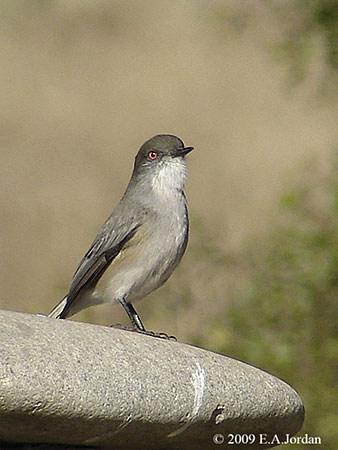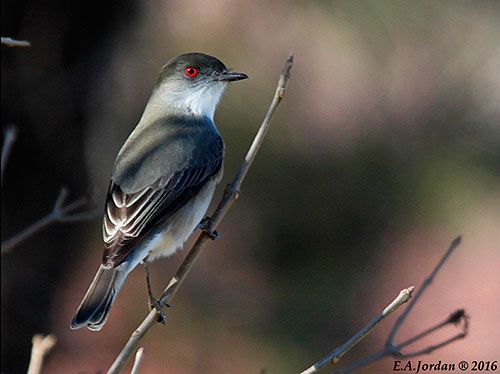
Fr: Pépoaza oeil-de-feu
Ang: Fire-eyed Diucon
All: Feueraugen-Scheckentyrann
Esp: Diucón - Monjita Diucón
Ita: Diucon
Nd: Vuuroogmonjita
Sd: eldögd monjita
Photographers:
John Anderson
John Anderson Photo Galleries
Eduardo Andrés Jordan
MIS AVES – AVES DE ARGENTINA
Text by Nicole Bouglouan
Sources:
HANDBOOK OF THE BIRDS OF THE WORLD Vol 9 - by Josep del Hoyo - Andrew Elliot - David Christie - Lynx Edicions - ISBN: 8487334695
Diucón (Fire-Eyed Diucon) Xolmis pyrope
HISTORIA NATURAL DEL DIUCÓN (XOLMIS PYROPE) EN CHILE CENTRAL, CON ÉNFASIS EN SU BIOLOGÍA REPRODUCTIVA
Argentina nativa - Diucón (Xolmis pyrope)
Sistema de Información de Biodiversidad de la Administración de Parques Nacionales, Argentina
Arthur Grosset's Birds (Arthur Grosset)
Wikipedia, the free encyclopaedia
Wikipedia, la enciclopedia libre
Fire-eyed Diucon
Pyrope pyrope
Passeriformes Order – Tyrannidae Family
INTRODUCTION:
The Fire-eyed Diucon is found in South America, in C and S Chile, SW Argentina and Tierra del Fuego. Two subspecies share the large range.
It usually frequents woodland, forest edge and farmland. It is often seen perched on shrubs and fences. It feeds primarily on insects, especially Rhyncophora. However, caterpillars, wild berries, cherries and grapes are also part of the diet, especially in winter.
The species is probably monogamous. They perform a fantastic flight display, before to build a cup-shaped nest in trees or flowering bushes, about 2-3 metres above the ground.
The Fire-eyed Diucon is the sole member of the genus Pyrope. It was formerly included in the genus Xolmis until 2020. The name “pyrope” comes from the Greek “purōpēs” meaning “eye of fire”.
The species is currently considered to be fairly common in natural habitats, with stable population. The Fire-eyed Diucon is not globally threatened at the moment.

DESCRIPTION OF THE BIRD:
Biometrics:
Length: 19-21 cm
Weight: 42,5-50 g
The Fire-eyed Diucon has grey upperparts with darker wings, especially the blackish flight-feathers showing white edges. The tail is grey with whitish edges to outer feathers.
On the underparts, chin and throat are white, but rest of underparts is pale grey. The flanks are tinged pale buff. The underwing shows blackish flight-feathers with white edges. The undertail is pale grey to whitish.
The head is grey with darker crown. Lower cheek, chin and throat are white.
The bill is black. The eyes are bright red. Legs and feet are black.
Male and female are similar.
The immature resembles adults, but the eyes are brown, not red. The plumage is duller, mostly pale brownish-grey.
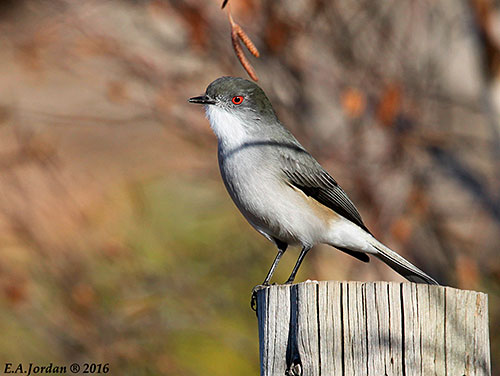
SUBSPECIES AND RANGE:
The Fire-eyed Diucon has two subspecies.
P.p. pyrope (described above) is found in the Andes of Central Chile and adjacent Argentina, S to Tierra del Fuego.
P.p. fortis is found on Chiloe Island (off S Chile). It is endemic to this island.
This race is slightly larger than nominate, with darker plumage.
HABITAT:
The Fire-eyed Diucon usually frequents open forest, edges of Nothofagus woodland, farmland and hedgerows.
The populations of both northernmost and southernmost parts of the range can be seen in more open habitat with scattered shrubs and trees.
CALLS AND SONGS: SOUNDS BY XENO-CANTO
The call of the Fire-eyed Diucon is a soft “pit” or “whit”. It also gives a short, high-pitched “tseet” sometimes given in series.
The song of this species includes short call notes ending in a flourish described as “pt wheet whut T-T- wheeeooo”.
During the flight displays, the bird produces a soft, single-note whistle.
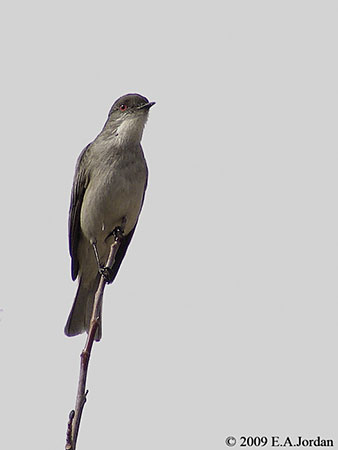
BEHAVIOUR IN THE WILD:
The Fire-eyed Diucon feeds primarily on insects, but in autumn and winter, it consumes numerous fruits, especially from Maytenus boaria, and wild fruits, cherries and grapes.
Insects are caught in flight by sallying to the air from a perch for flying insects, or dropping to the ground. The bird comes to the ground to catch the prey and quickly returns to a nearby perch with short, swift flight.
Adults have been observed feeding on hairy caterpillars and giving large caterpillars to their chicks.
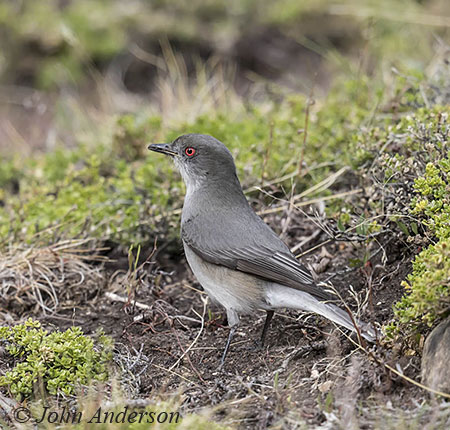
The Fire-eyed Diucon can be seen singly or in pair. The species is probably monogamous.
An observation on Chiloe Island off S Chile, allowed to describe the flight display, a daring inverted flight during which both wings and tail feathers are fully spread. The flight ends in the upper branches of a cypress tree. This display is preceded by a soft, single note whistle with descending tones.
The species builds a cup-shaped nest about 2-3 metres above the ground, often in Acacia caven, but also in native shrubs or trees.
The Fire-eyed Diucon of nominate race breeding in the southernmost part of the range is completely migratory. It is present year-round throughout most of the range, but it moves to north only during the southern winters, from Coquimbo to south of Antofagasta in N Chile.
It is vagrant between March and September in the Falkland Islands.
The subspecies P.p. fortis is endemic to Chiloe Island.
The flight is quiet, except during the courtship displays. When foraging, the bird performs aerial sallies before returning to the perch with a short, swift flight.
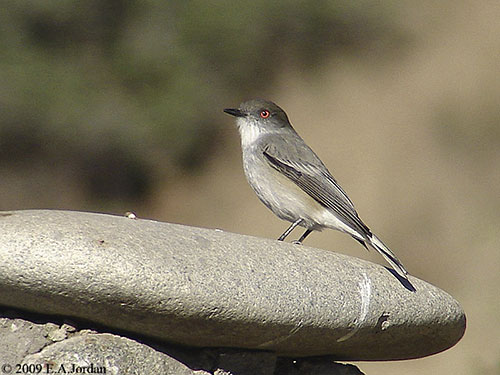
REPRODUCTION OF THIS SPECIES:
The breeding season extends from October to December-January in central Chile, with a peak in October.
An observation in a private reserve in Central Chile allowed to study the breeding biology of the Fire-eyed Diucon.
The bulky, cup-shaped nest is built in native shrubs or trees, with a preference for second growths of Acacia caven. The nest is made with sticks and a layer of mosses. It is lined with soft pieces of vegetation and mammalian hair or sometimes feathers of other bird species, depending on availability. The bulky structure is usually placed 2-3 metres above the ground.
The female lays 2-4 creamy-white eggs with reddish spots and blotches. The incubation, performed by one or both adults, lasts 17-19 days. Both parents feed the chicks mainly with ground-dwelling insects. However, an observation mentions large caterpillars given to the chicks. This type of diet indicates ground feeding behaviour of the adults, at least during the nesting period.
The nestlings leave the nest between 13 and 15 days after hatching. At this moment, their weight is about 32 grams.
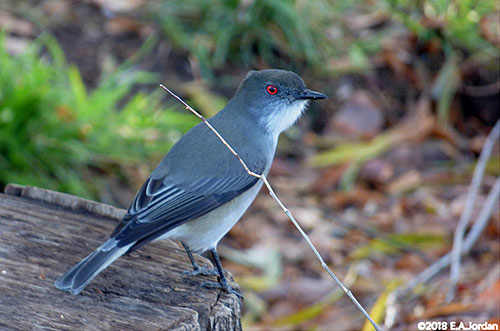
The nests of the Fire-eyed Diucon are parasitized by the Shiny Cowbird which lays its eggs in the nest of this species. These eggs are incubated and brooded by the adults, often to the detriment of their own offspring.
PROTECTION / THREATS / STATUS:
The Fire-eyed Diucon is described as fairly common throughout the large range, including in urbanized areas.
The size of the population is unknown, but it is suspected to be stable.
The Fire-eyed Diucon is currently evaluated as Least Concern.
